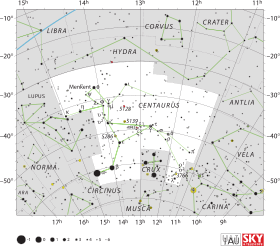Nu Centauri
 | |
| Observation data Epoch J2000.0 Equinox J2000.0 | |
|---|---|
| Constellation | Centaurus |
| Right ascension | 13h 49m 30.27644s[1] |
| Declination | –41° 41′ 15.7521″[1] |
| Apparent magnitude (V) | +3.41[2] |
| Characteristics | |
| Spectral type | B2 IV[3] |
| U−B color index | −0.891[4] |
| B−V color index | −0.234[4] |
| Variable type | Ellipsoidal + β Cep[5] |
| Astrometry | |
| Radial velocity (Rv) | +9.0[6] km/s |
| Proper motion (μ) | RA: –26.77[1] mas/yr Dec.: –20.18[1] mas/yr |
| Parallax (π) | 7.47 ± 0.17[1] mas |
| Distance | 437 ± 10 ly (134 ± 3 pc) |
| Absolute magnitude (MV) | −2.4[2] |
| Orbit[7] | |
| Period (P) | 2.622 ± 0.018 days |
| Eccentricity (e) | 0 |
| Periastron epoch (T) | 2450894.32 ± 0.01 |
| Semi-amplitude (K1) (primary) | 22.4 ± 0.4 km/s |
| Details | |
| Mass | 8.5 ± 0.3[3] M☉ |
| Radius | 6.4[8] R☉ |
| Luminosity | 5,000[2] L☉ |
| Surface gravity (log g) | 4.02[2] cgs |
| Temperature | 22,400[2] K |
| Rotational velocity (v sin i) | 90[9] km/s |
| Age | 18.2 ± 3.2[3] Myr |
| Other designations | |
| Database references | |
| SIMBAD | data |
Nu Centauri (ν Cen, ν Centauri) is a binary star system in the southern constellation of Centaurus. The combined apparent visual magnitude of the pair is +3.41,[2] making this one of the brightest members of the constellation. Based upon parallax measurements made during the Hipparcos mission, this star system is located at a distance of roughly 437 light-years (134 parsecs) from Earth. The margin of error for this distance is about 2%, which is enough to give an error in distance of ±10 light years.[1]
This is a single-lined spectroscopic binary system, which means that the two stellar components have not been individually resolved with a telescope.[7] Instead, their orbital motion can be tracked through periodic shifts in the spectrum of the primary. The gravitational perturbation of the hidden secondary component upon the primary is causing the latter to first move toward and then away from the Earth, creating Doppler shift changes in the spectrum. From these subtle shifts, the orbital elements of the pair can be extracted. The pair are orbiting their common center of mass in a circular orbit with a period of only 2.622 days, indicating that they are in a relatively tight orbit.[7]
The interaction between the two components of this system appears to be creating emission lines in the spectrum, turning the primary into a Be star.[7] It has a stellar classification of B2 IV,[3] which matches a massive B-type subgiant star. The primary has 8.5[3] times the mass of the Sun and 6.4[8] times the Sun's radius. It is a Beta Cephei type variable star with a brightness that periodically varies from magnitude +3.38 to +3.41 over an interval of 0.17 days.[7] The tidal interaction with the secondary component has turned it into a rotating ellipsoidal variable.
This star system is a proper motion member of the Upper-Centaurus Lupus sub-group in the Scorpius-Centaurus OB association, the nearest such association of co-moving massive stars to the Sun.[2]
References
- 1 2 3 4 5 6 van Leeuwen, F. (November 2007). "Validation of the new Hipparcos reduction". Astronomy and Astrophysics. 474 (2): 653–664. arXiv:0708.1752. Bibcode:2007A&A...474..653V. doi:10.1051/0004-6361:20078357.
- 1 2 3 4 5 6 7 de Geus, E. J.; de Zeeuw, P. T.; Lub, J. (June 1989), "Physical parameters of stars in the Scorpio-Centaurus OB association", Astronomy and Astrophysics, 216 (1–2): 44–61, Bibcode:1989A&A...216...44D
- 1 2 3 4 5 Tetzlaff, N.; Neuhäuser, R.; Hohle, M. M. (January 2011), "A catalogue of young runaway Hipparcos stars within 3 kpc from the Sun", Monthly Notices of the Royal Astronomical Society, 410 (1): 190–200, arXiv:1007.4883, Bibcode:2011MNRAS.410..190T, doi:10.1111/j.1365-2966.2010.17434.x
- 1 2 Gutierrez-Moreno, Adelina; Moreno, Hugo (June 1968), "A photometric investigation of the Scorpio-Centaurus association", Astrophysical Journal Supplement, 15: 459, Bibcode:1968ApJS...15..459G, doi:10.1086/190168
- ↑ Samus, N. N.; Durlevich, O. V.; et al. (2009). "VizieR Online Data Catalog: General Catalogue of Variable Stars (Samus+ 2007-2013)". VizieR On-line Data Catalog: B/gcvs. Originally published in: 2009yCat....102025S. 1. Bibcode:2009yCat....102025S.
- ↑ Wilson, R. E. (1953), General Catalogue of Stellar Radial Velocities, Carnegie Institute of Washington D.C., Bibcode:1953GCRV..C......0W
- 1 2 3 4 5 Schrijvers, C.; Telting, J. H. (November 2002), "Identification of non-radial pulsation modes in the close-binary beta Cephei star nu Centauri", Astronomy and Astrophysics, 394: 603–615, Bibcode:2002A&A...394..603S, doi:10.1051/0004-6361:20021154
- 1 2 Underhill, A. B.; et al. (November 1979), "Effective temperatures, angular diameters, distances and linear radii for 160 O and B stars", Monthly Notices of the Royal Astronomical Society, 189: 601–605, Bibcode:1979MNRAS.189..601U, doi:10.1093/mnras/189.3.601
- ↑ Bernacca, P. L.; Perinotto, M. (1970). "A catalogue of stellar rotational velocities". Contributi Osservatorio Astronomico di Padova in Asiago. 239 (1). Bibcode:1970CoAsi.239....1B.
- ↑ "nu. Cen". SIMBAD. Centre de données astronomiques de Strasbourg. Retrieved 2012-02-18.